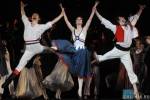Год выпуска: 2002
Страна: Канада
Жанр: фильм - балет
Продолжительность: 00-58.42
Перевод: Не требуется
Режиссер: Edourd Lock, композитор David Lang
В ролях:
Andrea Boardman,Nancy Crowley,Mistaya Hemingway. Keir Knight,Chun Hong
Li, Bernard Martin, Jason Shipley Holmes, Billy Cmith, Naomi Stikeman,
Zofia Tujaka.
Описание: Хореограф и постановщик - Edouard Lock, композитор - David Lang, стихи - Lou Reed, операторская работа - Andre Turpin.
В "Амелии" канадцы активно используют новые компьютерные технологии.
Потрясающая виртуозность, бешеные ритмы, темпы, и… пуанты, трактованные
совершенно неоклассично.
Доп. информация: Хореограф
Эдуар Лок родился в Касабланке (Марокко). В 21 год создал первую
хореографическую композицию для группы Nouvelle Air. За ней следует
продолжение еще их трех частей, которые в итоге объединяются в единый
балет и показываются в Монреале.
В 1980 Эдуар Лок основывает
и становится художественным директором танцевальной компании «Ла Ла Ла
Человеческие Шаги». Вскоре после постановки «Лили Марлен танцует в
джунглях», он начинает ставить за границей. Лок — первый канадский
артист, который был представлен в Нью-Йоркской «Кухне» театрального
авангарда 1980-х.
В 1981 он получает престижный приз J. A.
Chalmers за хореографию «Апельсинов», второго сочинения для собственной
компании. В 1983 следует постановка «Бизнесмен в процессе превращения в
Ангела».
С балетом «Пол человека», созданном в 1985, труппа
начинает кругосветное двухгодичное турне и имеет огромный успех у
зрителей и критики повсюду, в особенности в Нью-Йорке. Эта работа
выдвигает Эдуара Лока на международную арену и приносит премию «Бесси»
в 1986. В это же время Лок создает «Хлеб танцует» для Национального
Балета Нидерландов, «Новые Демоны», для открытия второго международного
Фестиваля нового танца в Монреале. Американский журнал U. S News and
World Report называет хореографа одним из 10 художников, повлиявших на
американскую культуру. В 1991-1995 появляется композиция Infante c'est
destroy. В 1996 — «Этюды» для Большого канадского балета в Монреале. В
1999 году хореограф создает «Приходя к заключению» для Нидерландского
Театра Танца.
В мае 2001 Эдуар Лок получает во второй раз
Национальный приз J. A. Chalmers в области танца. В июне 2001 Эдуар Лок
назван Кавалером Национального Ордена Квебека. И в ноябре того же года
удостоен награды Национального Центра искусства за исключительные
достижения последних сезонов. В феврале 2002 он стал Офицером Ордена
Канады, которым отмечают высшие, жизненные достижения. А министерство
культуры Квебека награждает его Призом Де-низ Пелетье, это самое
высокое отличие в области исполнительских искусств, существующее в
Квебеке. В октябре 2002 Эдуар Лок и «Ла Ла Ла Человеческие Шаги»
представили в Государственной Опере в Праге мировую премьеру «Амелии».
В ноябре 2002 Балет Парижской Национальной Оперы приглашает Эдуара Лока
на постановку AndreAuria.
http://www.kommersant.ru/doc.aspx?DocsID=518090 http://botinok.co.il/node/53874
Качество: DVDRip
Формат: AVI
Видео кодек: DivX
Аудио кодек: MP3
Видео: 720х480 29,97fps 1525 kbps
Аудио: 48000Hz 192 kbps











